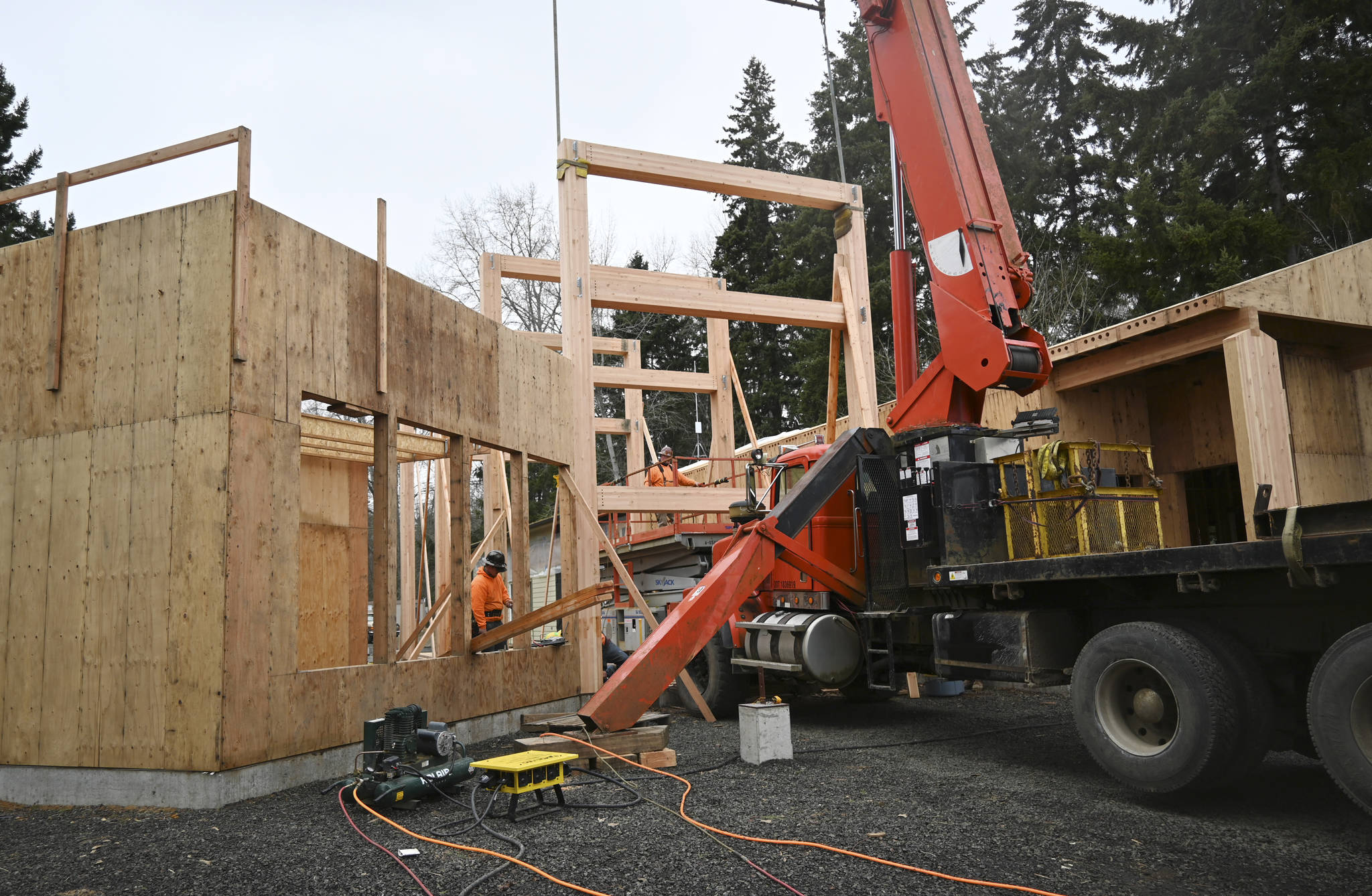SEQUIM — The most significant expansion to the Dungeness River Audubon Center since it opened in 2001 continues to take shape with a series of 3,000-pound trusses that echo the nearby historic railroad bridge.
Expected to open in the fall, the multi-million dollar project is transforming the community park into what partners from the center and Jamestown S’Klallam Tribe hope will become a destination location and tourist draw.
“(It’s) lot of hard work to see come through in a physical form,” center director Powell Jones said earlier this month.
He’s had a number of conversations with fellow Sequim natives who are local contractors working on the project as they help construct “a building that interprets a river they grew up with and knew and love,” Jones said.
While Sequim’s relatively mild winter weather hasn’t much slowed the expansion’s progress, the unexpected rise in building costs and scarcity of materials during the COVID-19 pandemic has created a funding gap, said Annette Hanson, chair of the “Inspire Wonder” capital campaign.
“We thought we are at our goal a year ago and then COVID hit,” she said last week.
Delays in shipping coupled with large increases in lumber and other materials has campaign officials looking for another $1 million or so, she said.
Most of the outer structures are paid for, but items such as interior furniture and fixtures make up much of the remaining costs, she said.
While campaign officials are “forever grant writing,” Hanson said — they’re working on three more this month — the group has a plan laid out to focus over the next nine months on connecting with businesses and individuals in the area who possibly would see the center as offering them opportunities, likely through drawing tourism to the area, she said.
As the first designated Audubon Center in Washington state, Hanson said, “when they hear about it, (we’ll have) more people coming to Sequim from across the country.
“It’s one more reason to keep them here another day.”
New-look center
The Dungeness River Audubon Center’s expansion will add 5,900 square feet of meeting and exhibit space to the facility and park adjacent to the Dungeness River and historic Railroad Bridge.
It will include an expanded area for interpretive exhibits, a commercial kitchen specifically designed for catering, a concession stand (including coffee), new entry, and a larger parking area with improved access to the River Center and the Olympic Discovery Trail.
The park’s popularity had over the years drawn about 50 community groups or government entities to use the center, putting a strain on the limited square footage.
“This takes the center to a whole new level of professionalism,” Hanson said. “Our capacity to serve the community is going to increase ten-fold.”
Annette Nesse, transportation program manager for the tribe, said that, while the park was already a popular place for locals and tourists, it wasn’t always clear to park users that anyone can go to the center to enjoy exhibits and programs.
“We can offer an obviously more-welcoming facility that anyone can enjoy; it wasn’t always obvious (before),” Nesse said.
The multi-functionality of the center will be a boon for groups struggling to find meeting rooms of a certain size in Sequim, partners in the project said.
Jones said he’s particularly excited to see tribal artwork both inside the center and on outside structures.
“We’ve always had a cultural connection, but I don’t think it’s obvious,” he said. “When people come into the center, they are definitely going to see a cultural presence of Jamestown S’Klallam Tribe, especially the art.”
The center will mirror the Dungeness River Bridge. Originally built in 1916 and replaced in 1930, it was abandoned for years until volunteers replaced planking and made it into part of a bike trail in the mid-1990s.
“(The center expansion) really ties a modern building with a 100-year-old transportation (structure),” Nesse said.
In June 2018, center and tribe partners announced the “Inspire Wonder” public fundraising campaign and — with community contributions, a $1.5 million state grant and $300,000 from the M. J. Murdock Charitable Trust — the fundraising drive had reached about 95 percent of the $2.9 million fundraising goal.
When two bids in particular exceeded the overall budget, project organizers chose to use the Jamestown S’Klallam Tribe — owners of the land upon which the center and park rest — as a general contractor and use a number of Olympic Peninsula-based subcontractors, a move they said not only cut costs but also provided local jobs.
Park officials shut down the center in mid-March 2020 due to the COVID-19 pandemic. Educational staff at the River Center shifted dozens of programs and courses online.
The move to a more “virtual” center experience has proved quite popular — an unexpected silver lining to the pandemic, Jones said.
“Twelve months ago I would have said we wouldn’t do a lot of online programming,” he said.
Instead, a River Center mid-week educational program earlier this month drew 105 unique visitors, many of whom had two people participating, for an estimated draw of 150.
That interest has Jones and others looking to keep virtual options available even after in-person programs are restored.
“COVID, as weird as it sounds, allowed us to develop those capacities,” Jones said.
The Jamestown S’Klallam Tribe, Dungeness River Audubon Center and Olympic Peninsula Audubon Society jointly manage the park and the center.
Expansion advocates encourage anyone seeking more information or to sponsor/contribute to efforts to get in touch with Hanson at 360-670-6774 or annette_hanson@msn.com, or Jones at powell@dungenessrivercenter.org.
Read more about the expansion, and watch video updates on construction, at dungenessrivercenter.org/our_story/building-expansion.
________
Michael Dashiell is the editor of the Sequim Gazette of the Olympic Peninsula News Group, which also is composed of other Sound Publishing newspapers Peninsula Daily News and Forks Forum. Reach him at editor@sequimgazette.com.

